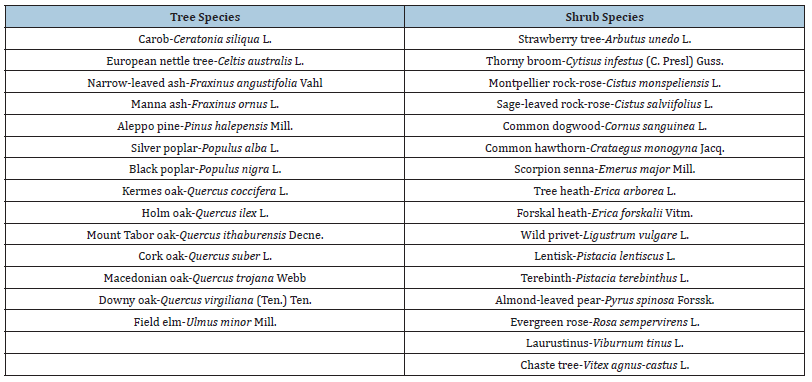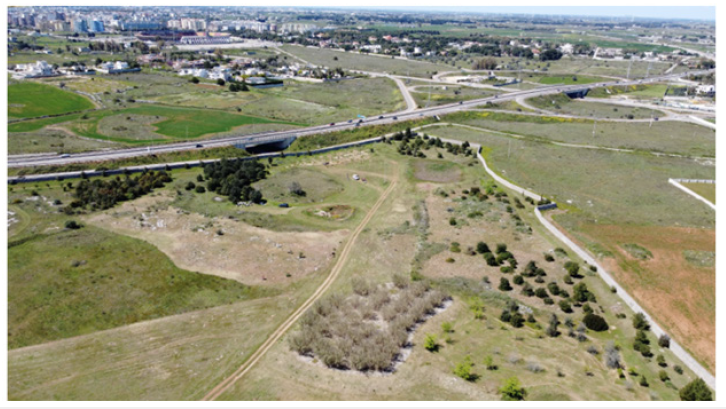- Submissions

Full Text
Biodiversity Online J
An Environmental Forestation Project in a Mediterranean Context (Salento Botanical Garden-Lecce): First results
Fabio I*
Department of Biological and Environmental Sciences and Technologies, University of Salento, Italy
*Corresponding author:Fabio Ippolito, Department of Biological and Environmental Sciences and Technologies, University of Salento, Lecce, Italy
Submission: June 20, 2022; Published: July 29, 2022

ISSN 2637-7082Volume3 Issue1
Introduction
Salento (‘heel of Italy’) has been affected over the last 10 years by a disastrous phenomenon of desertification, caused by the bacterial infection of Xylella fastidiosa, which has destroyed almost the whole population of olive trees (including numerous centuries-old specimens). This phenomenon, in addition to leading to a real productive collapse of the olive-growing sector, has led to a drastic impoverishment of the tree cover of the rural territory, already previously threatened by a progressive recrudescence of the impact of climate change (with increasingly torrid summers and frequent fires). Over the same period, the demand for green areas and natural landscapes has grown on the part of the region’s citizens, who are interested on the one hand in the regeneration of the devastated landscape and greater environmental defenses against climate change, and on the other hand in having more space for excursions and leisure time. However, the regeneration of the landscape is also essential to maintain a high level of attractiveness for tourists, who more and more often have started to visit the beaches, countryside, farms, and parks of the Salento. On these assumptions, forestation projects have multiplied in recent years, mainly supported by companies or charitable foundations. This paper illustrates one such case, which started in early 2021 in the Salento Botanical Garden.
Discussion
The construction of a huge botanical garden of Salento, in Lecce, was started in 2006, when on a 13-hectare plot of land work was carried out to establish a park based on the reconstruction of the most representative habitats of the southern part of Apulia [1]. The pedological environment consists of a mostly shallow, stone rich substrate resting on a limestone plateau with weak undulations. Originally, the predominant vegetation was a pseudo-steppa with perennial grasses (Hyparrhenia hirta (L.) Stapf or Stipa austroitalica Martinovský) and annual plants, frequented by grazing flocks of sheep and often burnt. The only trees were a few olive trees and three or four large almond-leaf pear trees. In the early 2000s, several infrastructures were built, including a dry-stone fence, an artesian well and irrigation system, landscaping paths and some buildings. Since 2006, many plants have been introduced to recreate the typical plant landscapes of Salento: Mediterranean scrub, garrigue, evergreen oak woods, orchards with figs, pears, and other species. “Arbolia” company, born from the collaboration between Snam and Fondazione Cassa Depositi e Prestiti (CDP), aims to implement projects to reduce and absorb CO2 emissions [2], by planting and creating new green areas on Italian territory, and at promoting concrete actions to combat climate change, improving air quality in cities, and creating green areas for the benefit of local communities, in line with national strategic priorities and the growing public interest in these issues. In this regard, in 2020 the Municipality of Lecce (Italy), in collaboration with the Foundation for the Management of the University Botanical Garden, identified and proposed an area on which to develop a reforestation project at the Salento Botanical Garden. The area chosen for planting is located within the perimeter of the Botanical Garden, on the edge of the Lecce by-pass, and covers approximately 30.000 square meters. The plants procured had to be of forest type, 2-3 years old (h. 0.60-0.80 approx.) in containers, autochthonous and certified, with phytosanitary passport, in compliance with national regulations. With reference to the Xylella fastidiosa regulations, not potentially vector species of the bacterium were used in the project. Selected essences had preferably to be sourced from forest nurseries in the area and, in the event of unavailability, within the same biogeographical strip of the intervention area. Below is the list of tree and shrub species selected for the planting project: The intervention area was divided into four sectors, named A, B, C and D. In these sectors, specific types of vegetation were recreated, based on the “structuring” species and in accordance with the typical habitats of the area [3], as represented in the sheet in (Table 1), through the planting of mixtures of tree and shrub species in the types shown in the sheet in (Table 2).
Table 1: Reference habitat.

Table 2: Tree and shrub species for planting project.

Indicatively, the planting pattern used was 2.5x2.5m (approximately 1,600 plants/ha); however, this planting scheme was adapted to the actual site-specific conditions encountered during the work, in consideration of the presence of already developed trees and shrubs and areas characterized by rocky outcrops. Of the total intervention area, approximately 2.5ha were dedicated to the planting of trees and shrubs for a total of approximately 4,000 plants; 0.5ha were allocated to grassy glades, the positioning of which was defined during the reforestation phase (Figure 1). Planting was carried out between 15 March and 30 April 2021 by manual digging or using a petrol-driven auger; each seedling was equipped with a stake and a coconut fiber mulching disc. During the summer of 2021, 7 rescue irrigations were carried out between the months of May and September by irrigating the single plants with a hose carried by an operator and water volumes of approximately 15 liters per plant. The on-site presence of a weather station for the direct recording of all climatic data facilitated the management of irrigation, depending on the actual water supply from rainwater. A drone flight was carried out at the same time as sowing, to have an as-built survey for use in subsequent monitoring. At the end of the hot season, a detailed survey of the surviving plants was carried out, subdivided by area and species, unfortunately revealing a rather high incidence of failures (over 70%); this seems to be due both to the exceptionally hot summer season, which led to extremely high soil temperatures, and to the fact that, for company requirements, spring sowing was preferred to autumn sowing, which is much more advisable, especially in a Mediterranean environment.
Figure 1: A panoramic view of the intervention area.

Conclusion
During the autumn of 2021, supplementary planting was carried out to replace the large number of unrooted individuals. A total of 2,180 seedlings were planted, belonging to the species that had given the best results in terms of rooting. In terms of planting areas, preference was also given to those with the highest number of rootings. Emergency irrigation started in May 2022, spaced at intervals of about 15 days and still ongoing. The only difference from last year is that a sprinkler irrigation is being carried out in sectors, which improves soil moisture conditions and feeds herbaceous vegetation that, while exerting water competition on the root systems, also improves moisture stagnation and provides thermal protection for the forest seedlings. The first results seem promising, but it will be necessary to wait until the end of the summer season to assess the effectiveness of the forestry techniques used.
Acknowledgement
I would like to thank: Prof. Luigi De Bellis for the scientific support to the project and to data collection; the Foundation for the Management of the University Botanical Garden, Arbolia s.r.l. - Eng. Enrico Cerelli, Dr Paolo Perno and Dr Tiziano and the Lecce Municipality’s Councillor for Spatial Planning Arch. Rita Miglietta for supporting the project; Dr Giordano Lualdi, Floema s.r.l. for the data provided.
-->References
- Chaudhry UK, Gökçe ZN, Gökçe AF (2020) Effects of salinity and drought stresses on the physio-morphological attributes of onion cultivars at bulbification stage. International Journal of Agriculture and Biology 24(6): 1681-1689.
- Gökçe ZNÖ, Gökçe AF, Junaid MD, Chaudhry UK (2022) Morphological, physiological, and biochemical responses of onion (Allium cepa L.) breeding lines to single and combined salt and drought stresses. Euphytica 218: 229.
- Chaudhry UK, Gökçe ZNÖ, Gökçe AF (2021) Drought and salt stress effects on biochemical changes and gene expression of photosystem II and catalase genes in selected onion cultivars. Biologia 76(10): 3107-3121.
- Ghodke P, Khandagale K, Thangasamy A, Kulkarni A, Narwade N, et al. (2020) Comparative transcriptome analyses in contrasting onion (Allium cepa L.) genotypes for drought stress. PloS one 15(8): 0237457.
© 2022 Usman KC. This is an open access article distributed under the terms of the Creative Commons Attribution License , which permits unrestricted use, distribution, and build upon your work non-commercially.
 a Creative Commons Attribution 4.0 International License. Based on a work at www.crimsonpublishers.com.
Best viewed in
a Creative Commons Attribution 4.0 International License. Based on a work at www.crimsonpublishers.com.
Best viewed in 







.jpg)






























 Editorial Board Registrations
Editorial Board Registrations Submit your Article
Submit your Article Refer a Friend
Refer a Friend Advertise With Us
Advertise With Us
.jpg)






.jpg)














.bmp)
.jpg)
.png)
.jpg)










.jpg)






.png)

.png)



.png)






